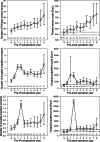Long-term health care utilisation and costs after spinal fusion in elderly patients
- PMID: 22907726
- PMCID: PMC3657062
- DOI: 10.1007/s00586-012-2479-5
Long-term health care utilisation and costs after spinal fusion in elderly patients
Abstract
Purpose: Spinal fusion surgery rates in the elderly are increasing. Cost effectiveness analyses with relatively short-length follow-up have been performed. But the long-term effects in terms of health care use are largely unknown. The aim of the present study was to describe the long-term consequences of spinal fusion surgery in elderly patients on health care use and costs using a health care system perspective.
Methods: 194 patients undergoing spinal fusion between 2001 and 2005 (70 men, 124 women) with a mean age of 70 years (range 59-88) at surgery were included. Average length of follow-up was 6.2 years (range 0.3-9.0 years). Data on resource utilisation and costs were obtained from national registers providing complete coverage of all reimbursed contacts with primary- and secondary health care providers. Data were available from 3 years prior fusion surgery until the end of 2009.
Results: Use of hospital-based health care increased in the year prior to and the first year following surgery. Hereafter it normalised to the level of the background population and was mainly composed of diseases unrelated to the spine. In contrast, the use of primary health care appeared to increase immediately after surgery and continued to increase to a level that significantly exceeded that of the background population. It could be demonstrated that the increase was mainly due to an increasing number of general practitioner consultations.
Conclusion: Spinal fusion surgery in older patients does not generate excess hospital-based health care use in the longer term as compared with the background population, but primary care use increases.
Figures

Similar articles
-
Revision lumbar surgery in elderly patients with symptomatic pseudarthrosis, adjacent-segment disease, or same-level recurrent stenosis. Part 2. A cost-effectiveness analysis: clinical article.J Neurosurg Spine. 2013 Feb;18(2):147-53. doi: 10.3171/2012.11.SPINE12226. Epub 2012 Dec 11. J Neurosurg Spine. 2013. PMID: 23231358
-
Comparative outcomes and cost-utility following surgical treatment of focal lumbar spinal stenosis compared with osteoarthritis of the hip or knee: part 2--estimated lifetime incremental cost-utility ratios.Spine J. 2014 Feb 1;14(2):244-54. doi: 10.1016/j.spinee.2013.11.011. Epub 2013 Nov 12. Spine J. 2014. PMID: 24239803
-
Factors influencing 2-year health care costs in patients undergoing revision lumbar fusion procedures.J Neurosurg Spine. 2012 Apr;16(4):323-8. doi: 10.3171/2011.12.SPINE11750. Epub 2012 Jan 27. J Neurosurg Spine. 2012. PMID: 22284228
-
[Controversies about instrumented surgery and pain relief in degenerative lumbar spine pain. Results of scientific evidence].Neurocirugia (Astur). 2007 Oct;18(5):406-13. Neurocirugia (Astur). 2007. PMID: 18008014 Review. Spanish.
-
Cost-Effectiveness for Surgical Treatment of Degenerative Spondylolisthesis.Neurosurg Clin N Am. 2019 Jul;30(3):365-372. doi: 10.1016/j.nec.2019.02.010. Epub 2019 Apr 10. Neurosurg Clin N Am. 2019. PMID: 31078237 Review.
Cited by
-
The Michel Benoist and Robert Mulholland Yearly European Spine Journal Review: a survey of the "surgical and research" articles in the European Spine Journal, 2013.Eur Spine J. 2014 Jan;23(1):9-18. doi: 10.1007/s00586-013-3126-5. Epub 2014 Jan 3. Eur Spine J. 2014. PMID: 24384830 Free PMC article. Review. No abstract available.
-
Risk Stratification of Elderly Patients Undergoing Spinal Surgery Using the Modified Frailty Index.Global Spine J. 2023 Mar;13(2):457-465. doi: 10.1177/2192568221999650. Epub 2021 Mar 22. Global Spine J. 2023. PMID: 33745351 Free PMC article.
-
Cognitive-Behavioral-Based Physical Therapy for Patients With Chronic Pain Undergoing Lumbar Spine Surgery: A Randomized Controlled Trial.J Pain. 2016 Jan;17(1):76-89. doi: 10.1016/j.jpain.2015.09.013. Epub 2015 Oct 23. J Pain. 2016. PMID: 26476267 Free PMC article. Clinical Trial.
-
Mortality in patients older than 65 years undergoing surgery for degenerative lumbar spine disease: a comparison with the general population.BMC Geriatr. 2024 Nov 15;24(1):944. doi: 10.1186/s12877-024-05533-w. BMC Geriatr. 2024. PMID: 39548361 Free PMC article.
-
Screw Loosening in Posterior Spine Fusion: Prevalence and Risk Factors.Global Spine J. 2020 Aug;10(5):598-602. doi: 10.1177/2192568219864341. Epub 2019 Jul 25. Global Spine J. 2020. PMID: 32677565 Free PMC article.
References
Publication types
MeSH terms
LinkOut - more resources
Full Text Sources
Medical

